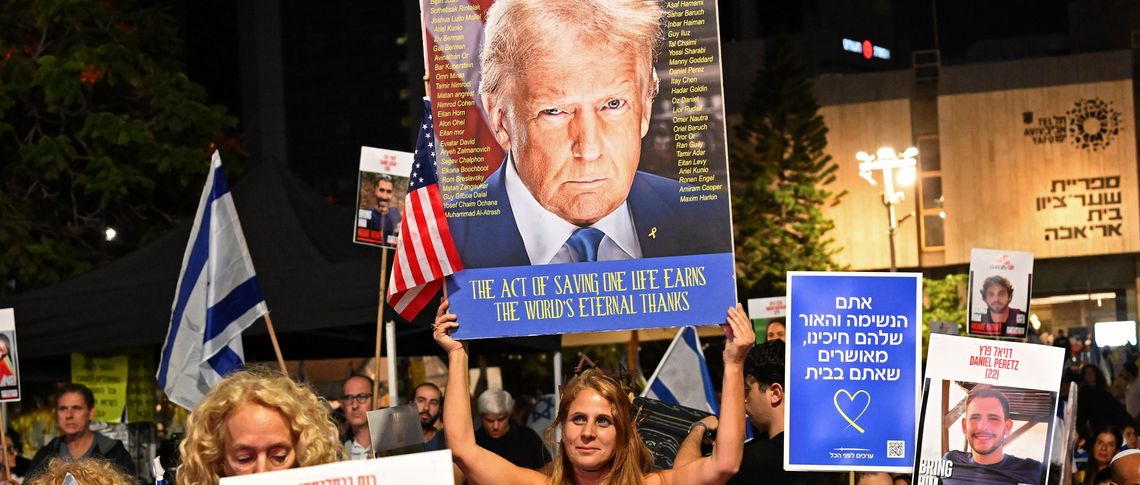Israel
The atmosphere in Israel in the days leading up to the safe return of the surviving hostages was electric. Hope and anticipation, almost exactly two years after the catastrophe of 7 October 2023, were tinged with anxiety that something might still go wrong at the last minute. And then, on that historic 13 October 2025, the jubilation over the liberation of the 20 surviving hostages was mixed with grief for those who would only return home dead or perhaps not at all.
The indirect agreement between Israel and the terrorist organisation Hamas came about as a result of the massive pressure exerted on both sides by US President Trump. This is undoubtedly to Trump’s credit — even if the individual components of the 20-point plan are not his invention, but have been under discussion for some time. The plan is remarkable not only because it is indeed substantial, but also because it represents a 180-degree turn from the US President’s earlier ideas (the ‘Riviera Plan’) and opens up the prospect of a Palestinian state.
It is difficult to predict how public sentiment will develop in the coming months.
As great as the joy in Israel is over the return of the hostages, the political divide remains clear. This became apparent not only when, shortly before the ceasefire and the release of the hostages, Trump’s special envoy Steve Witkoff’s speech to hundreds of thousands of Israelis in Tel Aviv was met with whistles and boos directed at Netanyahu amid the cheers for the US president. The fragility of the 20-point plan was also evident in its rejection by the two right-wing extremist ministers Smotrich and Ben-Gvir in the decisive cabinet meeting. Although their dissenting votes did not prevent the first phase of the agreement from going ahead, it is entirely possible that Netanyahu’s coalition will collapse over the next steps in the second phase of implementation, leading to early parliamentary elections — something that around half of the Israeli population has been calling for for a long time anyway.
It remains to be seen whether the symbolic peace ceremony, to which Trump and Egyptian President Abdel Fattah al-Sissi invited guests to Sharm el-Sheikh on Monday afternoon, will contribute to clarify the next steps or whether it will primarily prove to be a self-promotional exercise on Trump’s part. This is because the 20-point plan is vague on many points: Which states will participate in the international stabilisation force to secure the process? Will there be a UN mandate for this mission? Who will be part of the (technocratic) Palestinian transitional administration? How will the international ‘Board of Peace’, which Trump himself wants to chair, function? What role will the Palestinian Authority play? And above all: Will Hamas really disarm and will it be possible to exclude it from the post-war political process?
There is great relief in Israel over the end of hostilities and the prospect of a rapid improvement in the humanitarian situation in the Gaza Strip. Until Monday of this week, however, the hostage issue dominated public consciousness. It is difficult to predict how public sentiment will develop in the coming months, especially since the price, measured by the release of 2 000 Palestinian prisoners, was very high from Israel’s point of view. Current polls show that the current coalition does not have a majority. However, whether there will be a change in policy and a departure from the course of the Netanyahu government ultimately depends on the specific composition of the next Knesset. Nevertheless, there is an opportunity for an internationally supported and regionally embedded political process towards a two-state solution.
Ralf Melzer, FES Israel
Palestine
In the hours following the announcement of the agreement to end the war, videos from the Gaza Strip showed children dancing, people celebrating in the streets, and the first displaced persons making their way back to their homes — or what remains of them.
There is great relief throughout Palestine: relief over the end of the bombing, the expected and urgently needed import of humanitarian aid into the Gaza Strip, and the release of nearly 2 000 Palestinian prisoners, most of which were arrested under unclear circumstances during the Israeli campaign.
Systematic arrests under Israeli occupation are a continuing issue for all Palestinians. Almost every family has relatives in prison. Over 11 000 Palestinians remain in Israeli prisons, including 400 children and 3 500 people without trial. Human rights organisations consider the conditions of detention to be catastrophic, especially since 7 October 2023.
This is why the joy over the deal is more like a brief sigh of relief, clouded by ongoing suffering and doubts about a lasting peace solution. Twenty per cent of the population of the Gaza Strip has been killed or injured, and almost half of the more than 67 000 dead are women and children. A famine has been declared, and more than 55 000 children under the age of six are malnourished — a direct consequence of the Israeli blockade.
Palestinians want more than just an end to the bombing – they are demanding a political solution that guarantees their rights.
There is great concern among Palestinians that the ‘peace’ will not last. The experience with the last ceasefire in January this year offers little cause for hope. At that time, the Israeli government decided to break the deal, impose a complete blockade and attack Gaza City. The big question now is: what will happen after the photos with Donald Trump are taken? Palestinians want more than just an end to the bombing – they are demanding a political solution that guarantees their rights.
A technocratic transitional government in the Gaza Strip, as envisaged in the plan, supervised by a body without international legitimacy, does not offer sufficient prospects. This is reminiscent of the 1993 Oslo Accords: at that time, too, a technical transitional government was established in Palestine — the Palestinian Authority. However, this did not lead to the implementation of the Palestinians' right to self-determination. Although more and more countries are recognising Palestine as a state, the Israeli occupation continues. In addition, the Israeli government has repeatedly emphasised that it will never allow a Palestinian state.
For this reason, German and European engagement that focuses solely on reconstruction in the Gaza Strip is not enough. Instead, the current momentum should be used to mobilise international forces that will take concrete steps to advance a political perspective with Palestinian sovereignty and guaranteed rights.
Maria Dellasega, FES Palestine
Egypt
For Egypt, 13 October 2025 marks a historic day — both for better and for worse. The signing of the peace agreement in Sharm el-Sheikh, in the presence of Donald Trump, Friedrich Merz, Keir Starmer and Emmanuel Macron, but in the absence of Hamas and Israel, once again casts Egypt as the central mediator. However, international recognition of Egypt’s mediation efforts in recent days overshadows the bitter reality of the agreement. After all, Cairo had already presented a much more detailed plan back in March that was far more popular in the region but failed to gain the necessary international support.
The so-called Cairo Plan, approved by the Arab League, focused on regional solutions — such as a technocratic Palestinian transitional government and greater responsibility on the part of Arab states, above all Egypt, underpinned by international support. For Cairo, the Trump plan therefore effectively diminishes its role. Nevertheless, the Egyptian government is using the opportunity to hold direct talks with Hamas as the last remaining mediator – following Israel’s attack on Hamas in Qatar – and to back the US plan. Its motto is: better to be involved in a flawed mediation than to be excluded entirely. For even a partial success is important for host country Egypt.
For Egypt, the Gaza agreement is not only crucial for regional stability, but also in part for its own future.
Egypt has been preparing for months to rebuild the Gaza Strip and is now ready to go: aid deliveries via the Rafah border crossing, the construction of temporary shelters, the removal of rubble and the reconstruction of infrastructure — Egypt serves as the main transit hub. At the same time, the prospect of lucrative contracts for state-owned companies is raising economic hopes.
Among the Egyptian population, however, the prevailing sentiment is a desire for the suffering in Gaza to finally come to an end. The daily images of destruction, immeasurable human suffering and targeted Israeli attacks on protection zones have left many in a state of constant shock over the past two years. Cautious hopes for an end to the violence run through countless tea-time conversations in Cairo’s street cafés — accompanied by the anxious question: what if Hamas releases the hostages and Israel attacks again anyway? Confidence in the agreement being upheld is fragile. Many fear that the forced displacement of Palestinians to the Sinai could still become a reality. The questions remain: Can the American plan really bring security? Will all parties to the conflict abide by the agreements — and what happens if they don’t? Can Egypt remain a key player even after the agreement is signed — and at what cost? And finally: What if Israel continues the violence anyway — will the Arab states and the US then take action?
For Egypt, the Gaza agreement is not only crucial for regional stability, but also in part for its own future. It remains to be seen whether the country will be able to benefit economically and politically from its role in the second phase of negotiations and the planned reconstruction. In terms of security policy, Egypt’s close involvement as the main contact remains a risk — because coordination with the Israeli military and the numerous complex tasks involved in implementing the plan will become even more difficult for Cairo if international attention fades.
Ronja Schiffer, FES Cairo
Jordan
As elsewhere, Jordanians have mixed feelings about the implementation of the 20-point Gaza peace plan. The prospect of a ceasefire and the promise to resume humanitarian aid for the people of Gaza are generally welcomed. However, scepticism prevails as to how durable these commitments will be.
On the one hand, there are considerable doubts about Hamas’ willingness to agree to complete disarmament. It is emphasised that it remains unclear how much control the political leadership actually has over the military wing — or how unified the latter still is. On the other hand, there are references to previous broken ceasefires, for which Amman holds the Israeli government responsible. There are serious doubts that Israel’s political leadership will abandon its plans to annex Gaza and the West Bank, despite pressure from Washington. Widespread assessments suggest that the Israeli prime minister will deliberately keep the crisis simmering to secure his political survival at home.
As a staunch supporter of a two-state solution, Jordan has an overriding interest in finding a viable and realistic way to bring peace to the Gaza war without undermining this prospect.
These concerns are exacerbated by the numerous gaps in the plan. Many formulations remain vague and open to interpretation. In particular, it is unclear how the transition between the first and second phases is to be structured. Above all, the unresolved questions regarding future security and administrative arrangements, as well as Jordan’s subordinate role in this context, are cause for concern.
Added to this is the fact that the return of Gaza to Palestinian administration is being made conditional on reform of the Palestinian Authority — without this reform being linked in any way to the end or even the dismantling of Israel’s settlement policy in the West Bank. This raises considerable doubts about the sustainability of the entire approach.
Nevertheless, Jordan participated in drafting the specific points of the plan and was among its first supporters. In addition to the overriding desire to end the war and resume humanitarian aid, another consideration also played a role: despite all the gaps that had been identified, for historical reasons, the affairs of Gaza had always been viewed in the region primarily as a matter of relations between Egypt and Israel. As a staunch supporter of a two-state solution, however, Jordan has an overriding interest in finding a viable and realistic way to bring peace to the Gaza war without undermining this prospect.
Sven Schwersensky, FES Amman
Lebanon
Lebanon has also been at war for two years. Following Hezbollah’s attack on northern Israel on 8 October 2023, the pro-Iranian militia has been in conflict with Israel. As the leading force of the so-called axis of resistance, Hezbollah launched rocket attacks to open the northern front and push Israel toward a ceasefire as well as save Hamas from collapse. However, none of these goals were achieved. On the contrary, the Israeli war against Lebanon claimed more than 4 000 lives, including 316 children, and displaced over a million people. To this day, many Lebanese still doubt that the peace agreement will be carried out, partly because the fragile Lebanese government has little influence and violations by the Israeli army remain largely overlooked.
Although many Lebanese are hoping for peace, there is considerable scepticism about the Gaza deal — and for good reason. In November 2024, a ceasefire was agreed with Israel that was supposed to bring peace. However, everyday life tells a different story: since then, the Israeli army has violated the agreement more than 5 000 times, continues to hold positions on Lebanese territory south of the Litani River and repeatedly violates the country’s sovereignty. Since the end of the ceasefire, more than 300 targeted killings have been carried out by drones. People have long since grown accustomed to their constant humming, even over the capital Beirut.
Leading representatives of Hezbollah stress that a ceasefire in Gaza is a prerequisite for peace on the Lebanese-Israeli border.
A central component of the agreement is the withdrawal of Hezbollah and other armed groups 30 kilometres back from the Israeli-Lebanese border, behind the Litani River, as well as the complete disarmament of the militia. Although Hezbollah fighters have withdrawn, disarmament is progressing slowly.
At the beginning of August 2025, the Lebanese cabinet approved a step in this direction: the Lebanese army is to draw up a plan by the end of the year to place all weapons under state control. However, the decision was met with fierce criticism: while Hezbollah continues to refuse, some Palestinian groups in the refugee camps have already handed over their weapons to the army. But as long as Hezbollah does not surrender its weapons, the Israeli army will continue to attack villages in the south and east of the country and carry out targeted killings.
Leading representatives of Hezbollah stress that a ceasefire in Gaza is a prerequisite for peace on the Lebanese-Israeli border. If the agreement in Gaza holds, the militia would no longer have any reason to wage war against Israel – provided that the Israeli army ends its attacks on Lebanese soil. A stable Gaza front could thus remove an important trigger for regional escalation and open up the possibility for Lebanon to negotiate stronger protection under international law or existing UN resolutions.
The Lebanese people are eagerly awaiting the coming days. These could be decisive for Gaza, Lebanon and the entire Middle East. The people there simply want to live in peace and dignity at last.
Merin Abbass, FES Beirut










